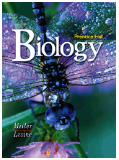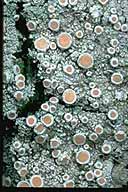BIOLOGY
by Miller & Levine
[complete Table of Contents]

|
Use the pull-down menu to jump to any of the Book's 40 Chapters: |
Additional Resources:
In this chapter, students will read about the structure, reproduction, and ecology of the members of the kingdom Fungi. They will also read about the characteristics that distinguish each of the four phyla of fungi. The links below lead to additional resources to help you with this chapter. These include Hot Links to Web sites related to the topics in this chapter, the Take It to the Net activities referred to in your textbook, a Self-Test you can use to test your knowledge of this chapter, and Teaching Links that instructors may find useful for their students.
| Hot Links | |
| Take it to the Net | Teaching Links |
What are Web Codes? |
Web
Codes for Chapter 21: |
![]()
Section 21-1: The Kingdom Fungi
![]() Fungi are eukaryotic
heterotrophs that have cell walls made of chitin.
Fungi are eukaryotic
heterotrophs that have cell walls made of chitin.
 The bodies of multicellular fungi are
composed of many hyphae tangled together into a thick mass called a mycelium.
The bodies of multicellular fungi are
composed of many hyphae tangled together into a thick mass called a mycelium.
 Most fungi reproduce both asexually and
sexually.
Most fungi reproduce both asexually and
sexually.
Section 21-2: Classification of Fungi
 Zygomycetes have life cycles that include
a zygospore.
Zygomycetes have life cycles that include
a zygospore.
 The phylum Ascomycota is named for the
ascus, a reproductive structure that contains spores.
The phylum Ascomycota is named for the
ascus, a reproductive structure that contains spores.
 The phylum Basidiomycota, or club fungi,
gets its name from the basidium, a specialized reproductive structure
that resembles a club.
The phylum Basidiomycota, or club fungi,
gets its name from the basidium, a specialized reproductive structure
that resembles a club.
 Deuteromycota is an extremely varied
phylum. It is composed of those fungi that are not placed in other phyla
because researchers have never been able to observe a sexual phase in
their life cycles.
Deuteromycota is an extremely varied
phylum. It is composed of those fungi that are not placed in other phyla
because researchers have never been able to observe a sexual phase in
their life cycles.
Section 21-3: Ecology of Fungi
 Fungi are found in every ecosystem, where
they recycle nutrients by breaking down the bodies of other organisms.
Fungi are found in every ecosystem, where
they recycle nutrients by breaking down the bodies of other organisms.
 Parasitic fungi cause serious plant and
animal diseases. A few fungi cause diseases in humans.
Parasitic fungi cause serious plant and
animal diseases. A few fungi cause diseases in humans.
 Some fungi form symbiotic relationships
in which both partners benefit. Two such mutualistic associations, lichens
and mycorrhizae, are essential to many ecosystems.
Some fungi form symbiotic relationships
in which both partners benefit. Two such mutualistic associations, lichens
and mycorrhizae, are essential to many ecosystems.
